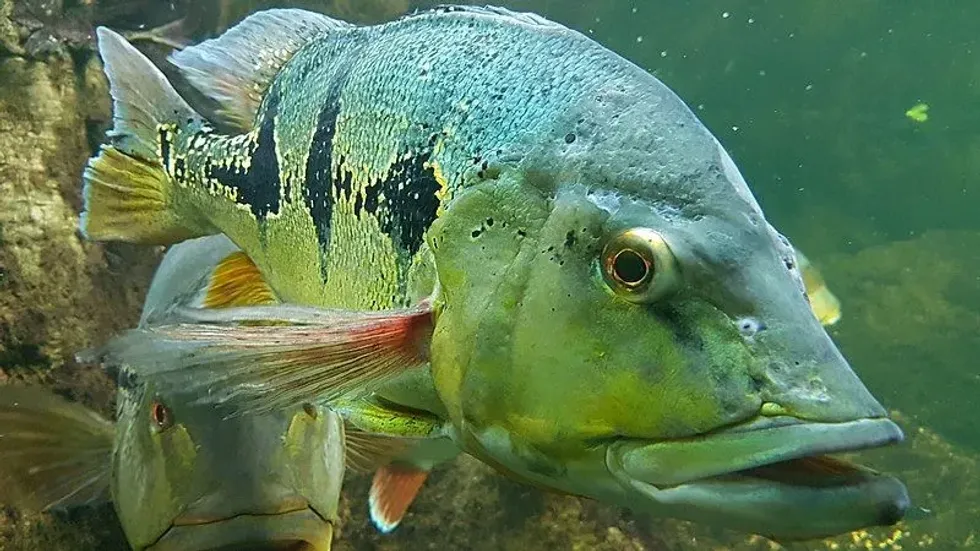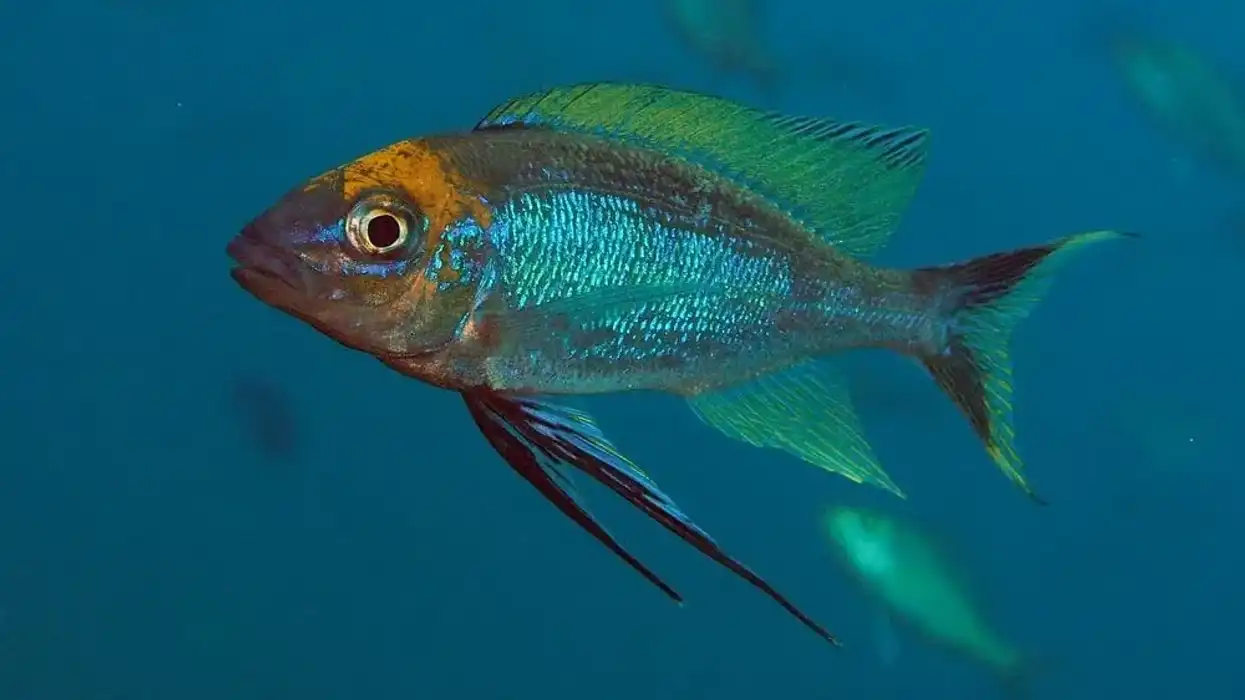Fish are fascinating creatures and one of the most beautiful of them is the peacock bass.
There are many kinds of peacock bass, such as the Kelberi peacock bass, Azul peacock bass, and the most common among them is the butterfly peacock bass. These exotic freshwater fishes are native to South America but were later introduced in some parts of Asia and North America too.
The color of their body ranges from olive green to golden, white, red, orange, black, and gray.
They also have a distinctive silver halo filled with black color on their caudal fin which makes them look more beautiful.
They can be sometimes confused with other common bass fishes like the largemouth bass, but it's important to know that they are completely different species than the largemouth bass.
They are not only a favorite of the fishermen and anglers in their native habitat, but they also have become a favorite all over the places they were later introduced to.
Even though peacock bass fishes are only one species among many of the Cichlid group, anglers and fishermen still know the species as Cichlid.
Read on to learn more about these amazing fishes and if you like this article, then check out the redear sunfish and the giant oarfish.
Peacock Bass Interesting Facts
What type of animal is a peacock bass?
Peacock bass is a type of freshwater fish that belongs to the family Cichlidae.
What class of animal does a peacock bass belong to?
The peacock bass species belongs to the class Actinopterygii of the animals.
How many peacock bass are there in the world?
This species of fish were introduced to many places in the interest of fishing and as sport-fish and in some places to control the population of other species of fishes. Nowadays they can be seen around the world kept as pets too. So, the exact number of these fishes is not known.
Where does a peacock bass live?
Many peacock bass species are native to Orinoco, Guiana, and Amazon river basin. Other than tropical South America, they can also be seen in some regions of Asia and North America too. They were introduced in Miami, South Florida, canals of Palm Beach countries, Panama's Gatun Lake, and a few have been seen in Australia too.
What is a peacock bass' habitat?
These fish like staying in rather warmer and medium-shallow waters. Their habitat includes ponds, lakes, canals, and rivers. This species of fish are mainly freshwater fish but they can also live in brackish waters.
Who do peacock bass live with?
In their native habitats, plenty of peacock bass can be seen. In the case of putting them in aquariums, as this species can grow pretty big in size and as they are predatory in nature, they can be seen kept alone in large fish tanks by enthusiasts.
These fish are also territorial in nature, which may lead to problems to keep many males of the species together but if the tank is big enough and has enough space, then many can live together.
How long does a peacock bass live?
When kept in aquariums or in other forms of captivity, these fish can be known to live up to 10 years old. Some among the species are even known to live as long as 15 years.
How do they reproduce?
The spawning, preparing for it and caring happens with the help of both the parent peacock bass fishes. The breeding season is around the months of May to June.
The parents look for a place that will be low on predators and has an abundance of prey. Then they clear it of algae or other kinds of vegetation.
The females of the species lay a row of eggs next and the males of the species then discharge the sperm over the rows. The females lay about 3,000-10,000 eggs and on average, the clutch size is about 5,000 eggs. Then when the eggs hatch, the parents carry them in their mouth to a certain nest they have made.
They usually keep the larvae all in one nest but they make a few more to baffle the predators. The parents take care of the fry for around 10 weeks.
What is their conservation status?
The species is Not Evaluated in the International Union for Conservation of Nature Red List. They are being introduced to various places and many people keep them in aquariums. They are also predators and grow in numbers pretty fast, so the species is not endangered or threatened.
Peacock Bass Fun Facts
What do peacock bass look like?

Peacock Bass can get pretty big in size. They have long bodies along with large mouths.
Many of the fish can be seen with humps on their foreheads. Peacock bass' teeth are small and their jaw is usually strong.
The colors and markings depend upon their location but in general, they are olive-green to golden white, with tinges of orange and red around the lower parts of the body including the fin. They have three dark-colored stripes on their body and around these stripes, some little dark spot-like markings can also be seen.
The upper part of their body including the fins may be grey or blackish in color.
Some white spots can also be present on some of the fins of the fish. On the caudal fin, a big silver halo filled with black color is present and the eyes of the fishes are red.
How cute are they?
Peacock bass are very colorful fish. Other than their predatory nature, they can be considered pretty cute.
Some people who don't mind keeping big fish in their home are known to keep this species of fish as pets too. They might not be cute in the conventional sense, but they sure are attractive with the plethora of beautiful eye-catching colors and markings on their body.
How do they communicate?
Peacock bass mostly uses sight, sound, and touch to communicate. They prefer to live in shallow clear waters so that they can see their prey and chase and hunt them.
This species of fish can hear sounds from far away places and sense the vibrations of animals in the water to get an understanding of their surroundings to a certain distance.
How big is a peacock bass?
On average, a peacock bass size is about 22-39.6 (55.8-100.6 cm) in length but can grow up to become almost about 3.3 ft (1 m) in length.
The speckled peacock bass is the largest of the species and grows to just over 36 in (91.4 cm) and the smallest, the royal peacock bass, grows to a maximum length of 22 in (55.8 cm).
Largemouth bass fish are a little larger than peacock bass and can grow up to be around 38.2 in (97 cm) in length.
How fast can a peacock bass swim?
Peacock bass can swim pretty fast as they rely a lot on speed to catch up to their prey.
How much does a peacock bass weigh?
Peacock bass can grow up to be pretty large. On average, they can weigh up to 29 lb (13 kg). The largest of the fishes that were introduced in the United States, weighed about 15 lb (6.8 kg).
What are their male and female names of the species?
There are no specific names for the males of the species or for the females of the species.
What would you call a baby peacock bass?
When fish lay eggs, they are called larvae. In the next stage, the young fish are called fry.
What do they eat?
Peacock bass are carnivorous in nature. They are predatory fish.
They eat almost all kinds of fish around them, but their diet mainly includes minnows, tilapia, mosquitofish, crayfish, tadpoles, and many other kinds of fishes. They are known to show cannibalism at times too.
They are introduced in many parts around the world to control the population of many species, but as these species of fish are invasive to some places, they have become a problem in the past. They not only have eaten the fish population of their surroundings quickly, but they also grow in numbers at the same speed.
Are they eaten by humans?
Yes, peacock bass are eaten by humans. When cooked, these freshwater fish taste sweet. The cooked fish has white flesh, no excessive oil, and they don't have many bones that will need to be plucked out.
Would they make a good pet?
Peacock bass are kept as pets by many people, but you need to meet a few requirements they need to live well.
As these fishes tend to get pretty large in size, they need large aquariums that should be at least 70 gal (318 L). They can get territorial at times, so it's better to not keep them with other male peacock basses.
They are also predatory in nature, so it's advisable to not keep them with other small fishes.
If you do decide to keep many of them together, then you'd need a larger aquarium to give each of the fishes their needed space. You'll need to change the water frequently and as they are easily affected if the oxygen level in the water gets low, keep an eye on the water plants.
Proper peacock bass care is important and if taken care of the right way, they will be your companions for around 10 years.
Did you know...
Peacock Bass are diurnal.
They may be invasive, but not in Florida. Butterfly peacock bass were introduced in the waters of Florida to control the population of the invasive Tilapia and Oscar. They have since been living there without affecting the ecosystem of their surroundings in Florida.
The Florida peacock bass has become a favorite for the anglers and fishermen in South Florida as game fish.
The largest world record peacock bass that was ever caught was from the Marié River in Brazil. This giant peacock bass weighed 31 lb (14 kg).
Peacock bass fishing can be done with both lures and bait but it depends upon the location. In the Amazon, people mainly use lures.
These fish are more active in shallow waters, so lures are a good option. Peacock bass fight a lot and they have strong jaws, so they often bite off the baits or lures and swim away with them. You would need a strong braided line to cope up with their strength and a lightweight fishing rod would be ideal.
When it comes to bait rather than lures, peacock bass bait needs to be perfect. Live bait would be more suitable to catch these fish than dead bait.
What water temperature can peacock bass survive in?
These fish prefer warmer waters and that's why they can be mostly seen in tropical climates, but if you are keeping a peacock bass at home, then you need to know the exact temperature to set for your aquarium. The perfect temperature is somewhere around 75-81 F (23.9-27.2 C).
They are rather sensitive to a temperature that is too warm or cold. Their required pH ranges from 6.5-7.5.
How do peacock bass feed?
Peacock bass hunt for food in two ways. They sometimes look for their prey on the surface of the water, like worms or crabs.
The other way they hunt is by chasing their prey. Peacock bass depend on their sight to identify their prey and that's why they need shallow clear water to survive. They are also fast, so once they target their prey they chase them and catch them.
Here at Kidadl, we have carefully created lots of interesting family-friendly animal facts for everyone to discover! Learn more about some other fish including catfish and tilefish.
You can even occupy yourself at home by drawing one of our peacock bass coloring pages.










